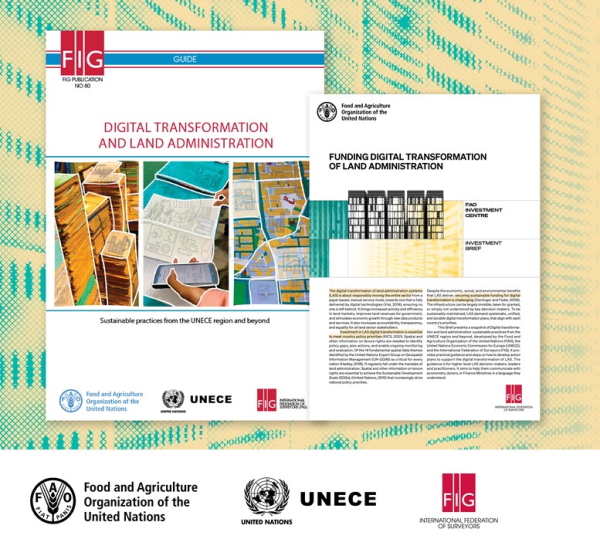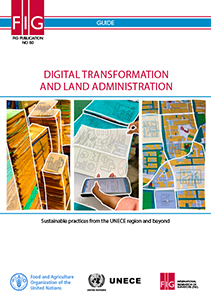| |
FIG PUBLICATION NO. 80
Digital transformation and land administration – Sustainable
practices from the UNECE region and beyond
FAO, UN AND FIG
GUIDE
FOREWORD
It is our pleasure to introduce this new publication. It is a collaborative work between
the Food and Agricultural Organisation of the United Nations (FAO), the United
Nations Economic Commission for Europe (UNECE), and the International Federation
of Surveyors (FIG).
The idea for the publication commenced from the recognition that the COVID-19 pandemic
impacted significantly on the land administration sector in many country contexts.
There were stories of success and stress in the face of the severe social disruption.
One of the key realisations was that land administration systems coped and often
thrived during lockdowns, and this was largely thanks to digital transformation. In
many countries, the digitalization of land administration services was accelerated. The
event saw increased demand to fundamental spatial and other information on tenure
rights for governments and citizens. It also demonstrated the importance of ensuring
no one is left behind, particularly women and vulnerable groups, when it comes to access
to digital land administration services.
Throughout the COVID-19 pandemic, the FAO, UNECE and FIG fostered dialogue between
countries using webinars to capture experiences and the key lessons. That
knowledge forms the basis for what is presented here. The publication delivers country-
level perspectives using case materials drawn mainly from the UNECE region. It
also takes a broader view of the contemporary land administration domain. It reveals
the digitally disrupted era that all land administration systems must now operate in.
It shows the benefits of accelerating digital transformation, but also the challenges. It
unpacks the key elements for future land administration systems and reveals the pathways
for taking action, sourcing financing including public investment, and achieving
implementation.
We hope land administrators can apply the lessons and knowledge within and use the
document to advocate for land administration advancement within their home country
contexts.
Our special thanks to Rumyana Tonchovska (FAO) who was the main initiator of this
publication, Frederick Zetterquist, Chair, UNECE Working Party on Land Administration
(WPLA) and Hana Daoudi (UNECE) as well as Hartmut Müller and Louise Friis-Hansen
(FIG). The drafting team with the three experts Rohan Bennett (in the lead), Claudia
Stöcker and Kwabena Asiama who did a remarkable job. Furthermore, we would like to
thank all those country level representatives who delivered content, and the dozens of
reviewers and proof readers.
Mohamed Manssouri
Director,
FAO Investment Centre
Rudolf Staiger
FIG President
Paola Deda
Director, Forests, Land and Housing Division
UNECE
Executive Summary
Starting from the digital disruptions triggered by the COVID-19 pandemic,
this publication examines the state-of-play and future directions for
digital transformation in land administration in the United Nations Economic
Commission for Europe (UNECE) region and beyond.
At the onset of the pandemic, many land administration organizations were
already well equipped for the new normal, adapting to working at-distance,
handling service spikes, responding swiftly to changing customer needs, and
delivering novel data analytics services. Legal arrangements to support
digital service delivery were often already in place or adaptable at short
notice. The event even produced financial gains for many land administration
organizations. Nevertheless, it also placed a spotlight on issues of digital
exclusion, data quality, standards, staff capacity, customer awareness, and
partner collaboration. These are areas where investment is most urgently
needed.
Digital disruption is the new normal for land administration organizations.
Successful systems already operate with this mindset and can pivot, adapt,
and learn on-the-fly – be it through leveraging off information technology
(IT) infrastructure investments, fast-tracking e-conveyancing, becoming more
data-driven, fostering dynamic capabilities, or supporting innovation
incubation hubs. Land administration and National Spatial Data
Infrastructure (NSDI) organizations should recognize digital disruption as
an opportunity to improve services and data quality, find new customers, and
create new services. To be equipped, digital transformation agendas for land
administration must align with broader governmental digital agendas,
infrastructure developments, and cybersecurity plans. Investment plans
should equally direct resources towards partnership building, capacity and
skills development, communication, and awareness-raising, to ensure they
deliver societal benefits and bridge the digital divide.
The COVID-19 pandemic evidenced the indispensable role that spatial and
other information on tenure rights play in supporting the government to
deliver on broader policy goals. They can help integrate cross-government
business processes, improve data supply lines, and support streamlining of
e-services for health management, emergency response, property market
stimulus, economic recovery, poverty reduction, protection of women and
vulnerable groups, climate change response, food security and agricultural
enhancement, disaster and conflict management, infrastructure provision,
government interconnectedness, open data initiatives, citizen and business
activation, and coordinated cybersecurity responses.
The land sector is accelerating towards fully digital operating
environments. They are establishing ‘dynamic capabilities’ to sense digital
opportunities, seize them and continuously transform business processes.
Capacity development programs are needed to further enhance these
capabilities. Authoritative, available, accurate, accessible, and
unambiguous digital datasets of land parcels, buildings, rights,
restrictions, responsibilities, and people must also be in place. Land
administration organizations are often responsible for the quality of 11 of
the 14 datasets identified as critical for effective Sustainable Development
Goals (SDGs) response. Land administration and NSDI leaders can adopt an
ecosystem mindset, assisting in the creation of inter-agency goodwill,
goals, sharing, and custodianship.
Future land administration systems must be ready to respond to a diverse
number of post-pandemic policy priorities including severe demographic
shifts, increasing societal disparities, economic volatility, newly
emerging business ecosystems, anthropogenic environmental damage,
decentralized operating environments, political power shifts, and rapid
urbanization. Equally, technological developments in cybersecurity, data
privacy and ethics, open data, artificial intelligence, robotics, digital
collaboration, innovation incubators, and crowdsourced data demand
attention. Platforms for partnerships with the business and education
sectors, as part of broader capacity development and community
awareness-raising, need consideration, alongside actions that better support
vulnerable groups, local communities, and deliver upon their basic data
needs.
Future land administration systems will require more intelligence,
interoperability, inclusivity, interactivity, incorporation, and investment.
They may need to explore ‘As-a-Service’, ‘Platform’ and ‘Distributed’
operational models, especially if these can enhance transparency,
accountability, reliability, ease of use, collaboration, cooperation, and
leadership. Redesigns must be fit-for-purpose and improve land-related
decision making, land tenure security, property valuation/taxation, land use
planning, land development, and land dispute minimization.
To implement these visions, a holistic approach towards digital
transformation is needed. It should incorporate key land administration
stakeholders and link to broader government policy goals. It should include
baseline assessments, policy alignment, benefits analysis, impact
assessment, an action plan, and an investment plan. These should consider
the nine strategic pathways from the United Nations Expert Group on Global
Geospatial Information Management (UN-GGIM) Integrated Geospatial
Information Framework (IGIF) and the Framework for Effective Land
Administration (FELA) and specific gaps and opportunities relating to those.
Costing of actions, sourcing of finance, and return on investment checks are
needed. Sustainable business models should consider fees and value-added
services. Performance monitoring and evaluation, utilizing data analytics
and dashboards, linked to the SDGs achievement, is essential.
Lessons from the UNECE region can transcend globally, provided contextual
factors are responsibly assessed. Supportive legislative environments,
coupled with economic stimulus and earlier investments into digital
infrastructure, saw land administration continue uninterrupted in many
non-UNECE contexts. In many cases, service delivery reached unprecedented
levels during the pandemic. In less digitally transformed contexts, halts in
face-to-face service provision resulted in request backlogs. Those in rural
contexts and the digitally disenfranchised, often women or vulnerable
groups, tended to fare worse. Technology can be a leveller, but also a
divider: equality to service access and skills development remains a key
priority.
Looking ahead, land administration organizations can build from the
momentum of the recent COVID-19 pandemic success stories. They must
re-evaluate current action and investment plans for digital transformation
and further opportunities for acceleration. Short-term actions should ensure
requisite cross-sector committees are in place, sector-wide adoption of the
disruption paradigm, and global and regional engagement, potentially with
donors. Medium-term actions should seek plan adoption, investment funding
and implementation. Monitoring of risks, benefits and performance measures
will be necessary. Embedding of dynamic capabilities needs to be supported.
Where responsible to do so, full digital transformation is now achievable.
Chapters
1 Introduction
2 Embracing digital disruption – Ensuring and improving
3 Understanding accelerated digitization – Leveraging land information
from land administration
4 Advancing dDigital transformation – Strategies for sustainable
digitalization in land administration
5 Implementing and benefiting – Action and investment plans for land
administration
6 Impacting Globally – Lessons and outreach for the international land
administration sector
7 Conclusions and way forward
Drafting team:
Rohan Bennett
Claudia Stöcker
Kwabena Asiama
Read the full FIG Publication 80 in pdf
The publication is also available at:
https://doi.org/10.4060/cc1908en
FIG Guide and FAO Investment Brief
Read more about the two publications that were published, FIG Guide and
FAO Investment Brief:

FAO, UNECE and FIG. 2022. Digital transformation and land administration – Sustainable practices from the UNECE region and beyond. FIG Publication, No. 80. Rome, FAO and UNECE. https://doi.org/10.4060/cc1908en
All rights reserved.
International Federation of Surveyors (FIG)
Kalvebod Brygge 31–33
DK-1780 Copenhagen V
DENMARK
Tel. + 45 38 86 10 81
E-mail: FIG@FIG.net
www.fig.net
ISBN [FAO] 978-92-5-136837-4 (pdf)
ISSN 2311-8423 (pdf)
© FAO and UN, 2022
Layout: Lagarto
|

























